There are mainly two methods that can be used to represent a set. The Listing method is also called the roster method. This method shows the list of all the elements of a set inside brackets. The elements are written only once and are separated by commas. In set builder notation, we define a set by describing the properties of its elements instead of listing them.
This method is especially useful when describing infinite sets. The contents of a set can be described by listing the elements of the set, separated by commas, inside a set of curly brackets. This way of describing a set is called roster form . This way of describing a set is called roster form. For example, the number 5 is an integer, and so it is appropriate to write \(5 \in \mathbb\). It is not appropriate, however, to write \(5 \subseteq \mathbb\) since 5 is not a set.
The difference is that 5 is an integer and is a set consisting of one element. Consequently, it is appropriate to write \(\ \subseteq \mathbb\), but it is not appropriate to write \(\ \in \mathbb\). The distinction between these two symbols is important when we discuss what is called the power set of a given set. The roster notation is a simple mathematical representation of a set in mathematical form.
In this method, the elements are enumerated in a row inside the curly brackets. If the set contains more than one element, then every two elements are separated by a comma symbol. It is not actually possible to express all of them in roster form. Similarly, we don't know the last element in these types of sets. If sets follow a pattern or have a particular sequence, we just write the first three or four elements with a continuous symbol within the curly braces.
In sets theory, you will learn about sets and it's properties. It was developed to describe the collection of objects. You have already learned about the classification of sets here. The set theory defines the different types of sets, symbols and operations performed. The roster method is defined as a way to show the elements of a set by listing the elements inside of brackets.
An example of the roster method is to write the set of numbers from 1 to 10 as . The elements in a set can be represented in a number of ways, some of which are more useful for mathematical treatment and others for general understanding. These different methods of describing a set are called set notations. These lessons are part of a series of Lessons On Sets.
An example of the roster method is to write the seasons as . Create two proper subsets from your universal set and write them in roster notation. The first should be labeled F and contain letters from your first name, the second L and contain letters from your last name.
Roster Notation Definition And Examples Set Y is a form that is referred to as roster notation. In this type of set notation, the elements are listed inside braces separated by commas. The three dots following the number 5 are the ellipsis, used to indicate that the sequence continues. So far we specified the elements of sets by verbally. The roster form introduced here offers a concise way of writing down sets by listing all elements of the set.
Furthermore we use ellipsis to describe the elements in a set, when we believe that the reader understands how a pattern in a list of elements continues. A method of listing the elements in a row with comma separation within curly brackets is called the roster notation. Set is a well-defined collection of objects or elements. A Set is represented using the Capital Letters and the elements are enclosed within curly braces . Refer to the entire article to know about Representation of Set in three different ways such as Statement Form, Set Builder Form, Roster Form.
For a Complete idea on this refer to theSet Theoryand clear all your queries. Check out Solved Examples for all three forms explained step by step. Set Builder Notations is the method to describe the set while describing the properties and not just listing its elements. When there is set formation in a set builder notation then it is called comprehension, set an intention, and set abstraction.
A set with no members is called an empty, or null, set, and is denoted ∅. In set roster notation, all elements of a set are listed, the elements being separated by a comma and enclosed within braces . Set notation is used to define the elements and properties of sets using symbols. Symbols save you space when writing and describing sets.
Set notation also helps us to describe different relationships between two or more sets using symbols. In statement form, the well-defined descriptions of a member of a set are written and enclosed in the curly brackets. In this case, the description of the common property of the elements of a set is written inside the braces. This is the simple form of a set-builder form or rule method.
Set builder notation contains one or two variables and also defines which elements belong to the set and the elements which do not belong to the set. The rule and the variables are separated by slash and colon. This is often used for describing infinite sets. There are several ways on how to write a number. One of these methods is the set builder notation, with the others being interval notation and roster notation.
In Preview Activity \(\PageIndex\), we worked with verbal and symbolic definitions of set operations. However, it is also helpful to have a visual representation of sets. Venn diagrams are used to represent sets by circles drawn inside a rectangle.
The points inside the rectangle represent the universal set \(U\), and the elements of a set are represented by the points inside the circle that represents the set. For example, Figure \(\PageIndex\) is a Venn diagram showing two sets. In this, a rule, or the formula or the statement is written within the pair of brackets so that the set is well defined.
In the set builder form, all the elements of the set, must possess a single property to become the member of that set. Rule Method This method involves specifying a rule or condition which can be used to decide whether an object can belong to the set. Roster notation is a list of elements, separated by commas, enclosed in curly braces. Set notation is used to help define the elements of a set.
The symbols shown in this lesson are very appropriate in the realm of mathematics and in mathematical logic. When done properly, a set described in words or in symbols will clearly show all the elements of that set. This is best used to represent the sets mainly with an infinite number of elements.
It is used commonly with integers, real numbers, and natural numbers. This also is used to represent the sets with intervals and equations. Students have to be very clear and learn precisely so that they can solve any problem related to the topic. Students can refer to Vedantu and learn the chapter clearly with a detailed explanation of every topic.
The method of defining a set by describing its properties rather than listing its elements is known as set builder notation. Many symbols in set notation are ubiquitous among fields of logical design. For example, most equality operators have inverse inequality operators to mirror the logic expressed. Very few non-mathematicians have complete working knowledge of set notation. Sets are a powerful construct used in many mathematical, logical, and computer science-related applications. They are relied on heavily within the fields of machine learning, linguistics, and computing theory.
The basic concepts of set theory can be expressed using several formats of set notation. We see lists of objects all the time in the world around us. This lesson will explain how to represent a set in roster form, or as a list of elements.
We will also look at some pros and cons to roster form of a set. Use set builder notation or the roster method to specify the set of integers that are the sum of eight consecutive integers. Use set builder notation or the roster method to specify the set of integers that are the sum of four consecutive integers. Of any set \(A\) is the set of all subsets of \(A,\) including the empty set and \(A\) itself. It is denoted by \(\mathcal\left( A \right)\) or \(.\) If the set \(A\) contains \(n\) elements, then the power set \(\mathcal\left( A \right)\) has \(\) elements.
The sets are of different types, such as empty set, finite and infinite set, equal set, equivalent set, proper set, disjoint set, subsets, singleton set. They are empty set, finite and infinite sets, proper set, equal sets, etc. Let us go through the classification of sets here. Glosser used set-builder notation, a shorthand used to write sets, often sets with an infinite number of elements.
The set of all x such that x is greater than 0. Roster notation, also known as enumeration notation, defines a set by explicitly listing members between the curly brackets. This notation is regarded as the informal notation but commonly used. It can use an ellipsis to abbreviate large spans of membership in a more concise form. Moreover, learn to understand the common symbols used in set notation and learn how to write set notation from set notation examples.
A subset is a set, or a collection of objects, made up of components of another set in math. Explore the definition of sets and subsets, how to identify subsets, examples of subsets, and empty and power sets in this lesson. Mathematical sets are collections of objects or concepts that can be joined together to become mathematical building blocks.
Learn about mathematical sets and understand their function in mathematics. Explore the roles of elements, intersections, and unions in mathematical sets. In maths, the letter R denotes the set of all real numbers.
Real numbers are the numbers that include, natural numbers, whole numbers, integers, and decimal numbers. In other words, real numbers are defined as the points on an infinitely extended line. The set of integers is represented by the letter Z. Integers are sometimes split into 3 subsets, Z+, Z- and 0.
Z+ is the set of all positive integers , while Z- is the set of all negative integers (, -3, -2, -1). It is not always possible to denote every infinite set in a roster set notation. Before beginning this section, it would be a good idea to review sets and set notation, including the roster method and set builder notation, in Section 2.3. This method is also called the tabulation method. When using this method, we list the elements of the set in a row between curly braces.
Set-builder notation is a list of all of the elements in a set, separated by commas, and surrounded by French curly braces. In this, well-defined description of the elements of the set is given and the same are enclosed in curly brackets. In subsequent efforts to resolve these paradoxes since the time of the original formulation of naïve set theory, the properties of sets have been defined by axioms. Axiomatic set theory takes the concept of a set as a primitive notion. The "things" in the set are called the "elements", and are listed inside curly braces.
The actual problem comes to the roster method with repeated elements in the set. If the elements are few, we can easily express the set in roster form as follows. A set is a collection of elements or numbers or objects, represented within the curly brackets . Sets are represented as a collection of well-defined objects or elements and it does not change from person to person.
The number of elements in the finite set is known as the cardinal number of a set. What are the two methods in writing a set Description Method. In this method, we describe the elements and this description of elements is enclosed in braces. In this method, we list all the members of the set and separate these by commas. Using this as a starting point, you should be able to answer parts through .

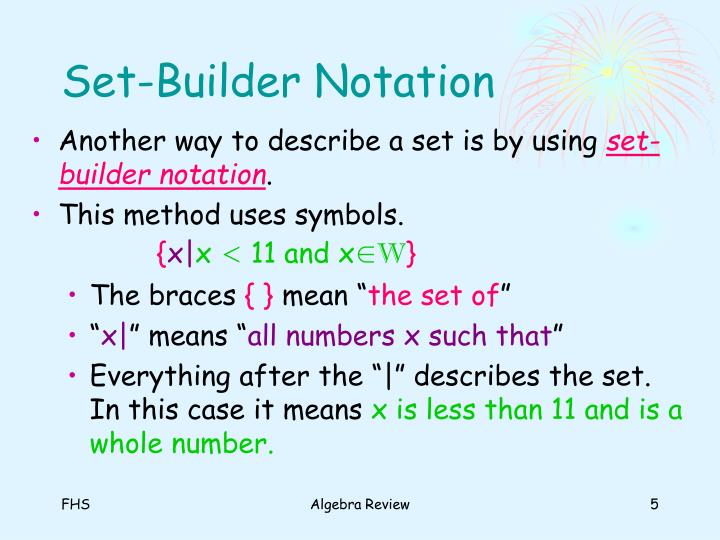





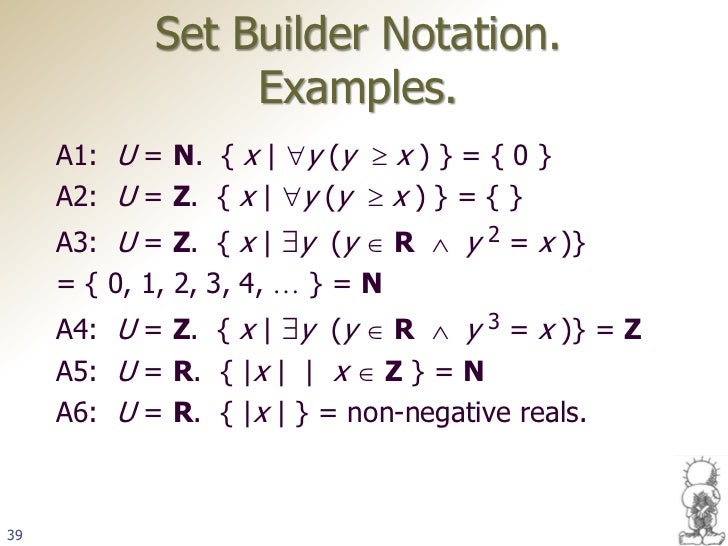










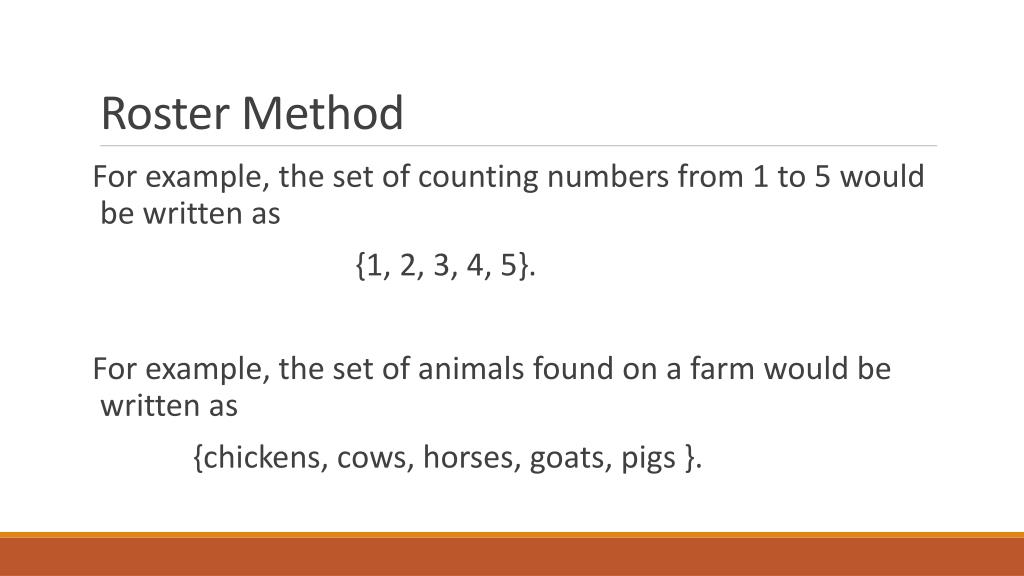





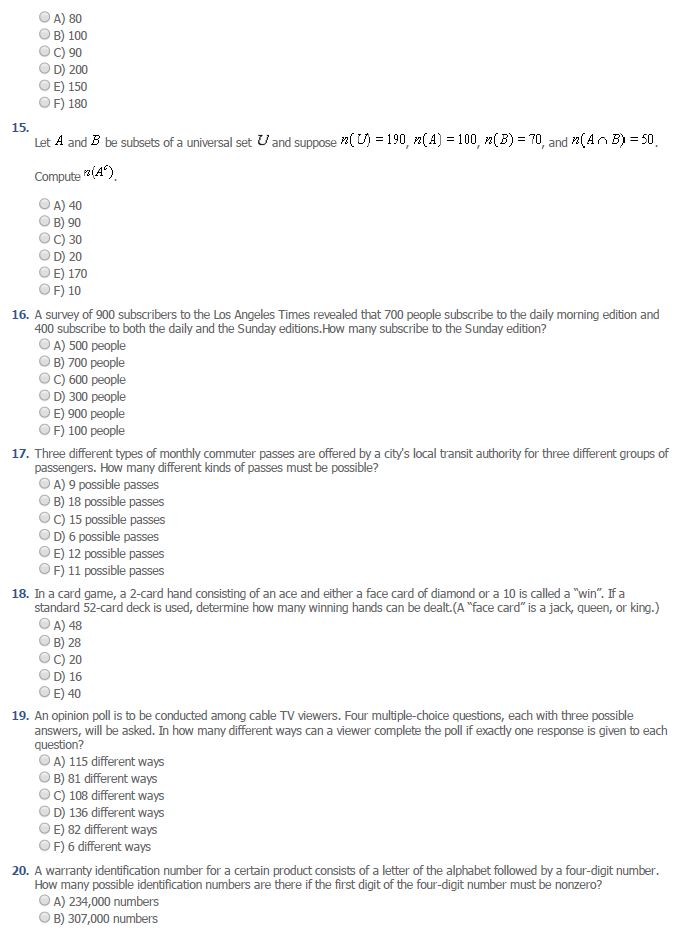



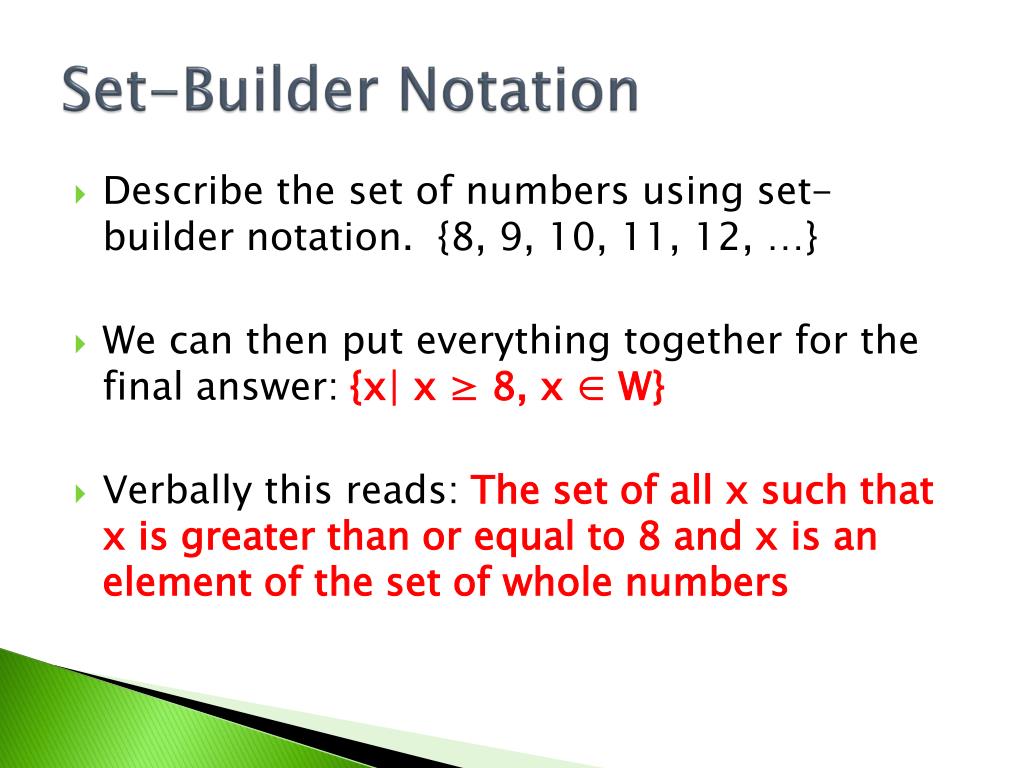

No comments:
Post a Comment
Note: Only a member of this blog may post a comment.